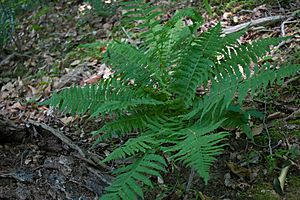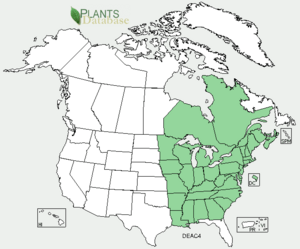Silvery glade fern facts for kids
Quick facts for kids Silvery glade fern |
|
|---|---|
 |
|
| Conservation status | |
| Scientific classification | |
| Genus: |
Deparia
|
| Species: |
acrostichoides
|
 |
|
| Range within North America | |
| Synonyms | |
|
|
The silvery glade fern, also known as silvery spleenwort, is a type of fern that lives for many years. Its scientific name is Deparia acrostichoides. This fern gets its "silvery" name from the shiny, silver-colored coverings found on the underside of its leaves. These coverings are called indusia and they protect the fern's spores as they grow.
You can find this fern in many parts of eastern United States and Canada. It grows from Ontario to Nova Scotia, and south to Georgia and Louisiana. It also lives in eastern Asia, including China, Russia, Japan, and Korea.
Contents
What the Silvery Glade Fern Looks Like
The silvery glade fern has yellowish-green leaves that grow from a strong stem. This stem is usually green, but can be a bit brown and hairy near the bottom. The stem often has a groove on its top side. It is much shorter than the leaf itself.
Leaves and Leaflets
The leaves of this fern are widest in the middle. They have a long, pointed tip and get narrower towards the bottom. The lowest pair of small leaves, called leaflets, usually point downwards. This special shape helps tell the silvery glade fern apart from other similar ferns.
The leaves can be quite large, from 30 to 80 centimeters (about 1 to 2.5 feet) long. They are also 10 to 25 centimeters (about 4 to 10 inches) wide. The underside of the leaves feels a bit fuzzy because it's covered in tiny yellow-green hairs. Each main leaf has about 18 smaller leaflets. These leaflets are about 15 centimeters long and 1 centimeter wide. They are usually straight and are cut into even smaller, oblong parts called subleaflets. These subleaflets often have a blunt or rounded tip.
Spores and Reproduction
Both the leaves that make spores and those that don't look very similar. The leaves that produce spores have small clusters called sori on their underside. When they first appear, these sori are silvery-green. As they get ready to release spores, they turn a light brown color.
The sori are arranged in a pattern that follows the veins of the subleaflets. They are usually straight or slightly curved. Each sorus has a thick indusium that protects the developing spores. The term "acrostichoid" in the fern's scientific name, D. acrostichoides, comes from how the spore cases (called sporangia) cover almost the entire underside of the leaf surface when they are mature.
Where the Silvery Glade Fern Grows
The silvery glade fern often grows in large groups. It spreads using roots that creep along the ground. You can commonly find this fern in moist places like stream bottoms, shaded woods, and other cool, damp areas throughout its range.
Images for kids






